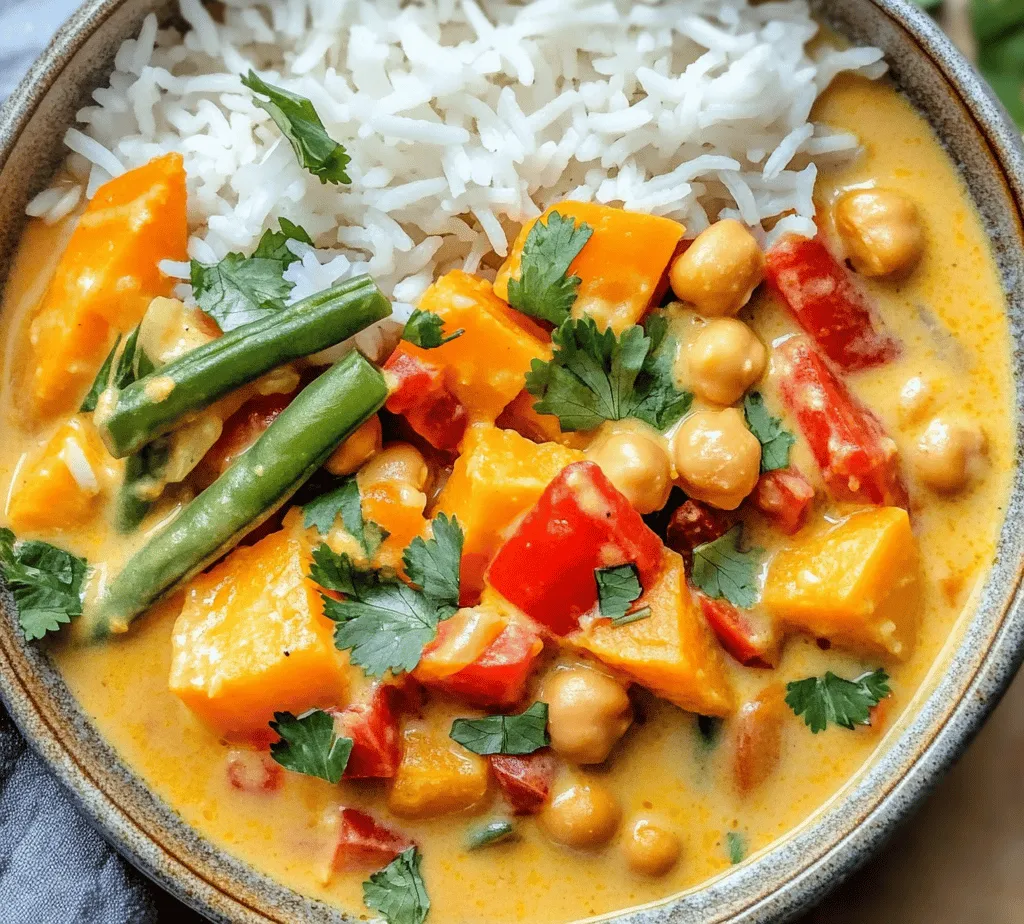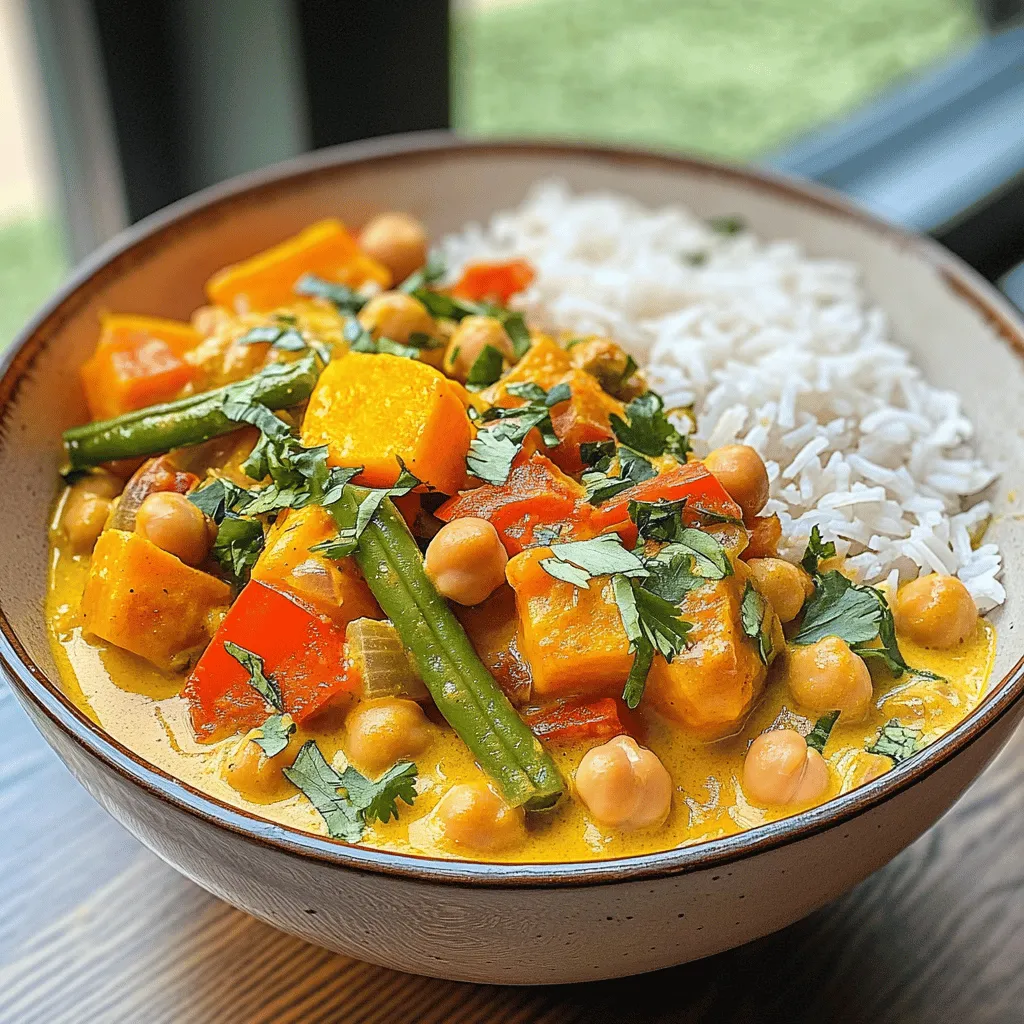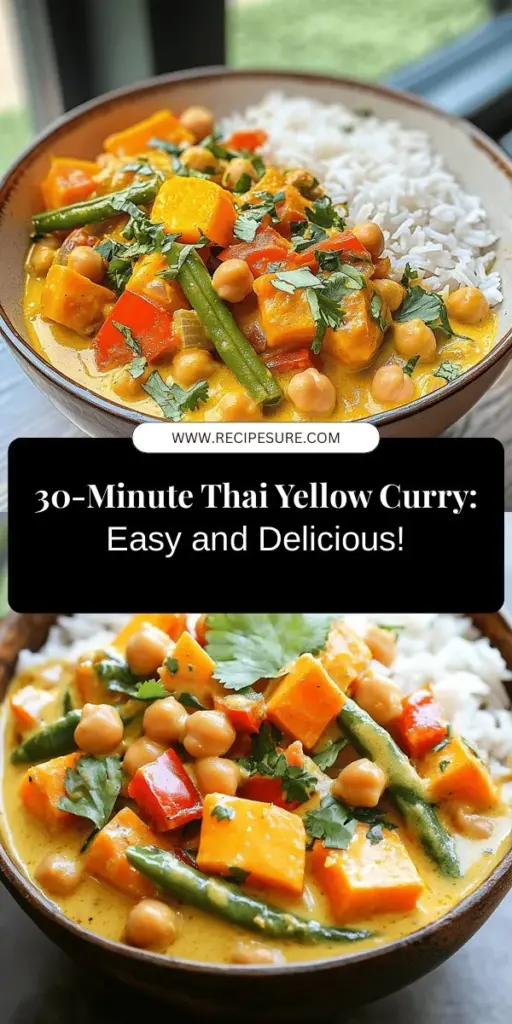Introduction
Thai cuisine is renowned for its vibrant flavors, aromatic spices, and fresh ingredients, offering a culinary experience that excites the senses. Among the many delightful dishes that Thai cooking has to offer, Thai yellow curry stands out as a perfect blend of spice and comfort. This easy 30-minute Thai yellow curry recipe simplifies the process of creating this beloved dish, allowing you to enjoy an authentic taste of Thailand without spending hours in the kitchen.
In just half an hour, you can whip up a delicious meal that not only satisfies your taste buds but also nourishes your body. The recipe features wholesome ingredients such as coconut milk, sweet potatoes, and chickpeas, making it an excellent option for those seeking plant-based meals that are both nutritious and filling. Coconut milk provides a creamy texture that envelops the spices, while sweet potatoes add a touch of sweetness and substance. The inclusion of chickpeas not only enhances the protein content but also brings a delightful texture to the dish.
Whether you’re a busy professional, a parent juggling multiple responsibilities, or simply someone who appreciates the convenience of quick cooking, this Thai yellow curry recipe is designed for you. It’s perfect for weeknight dinners, meal prep, or impressing guests with minimal effort. Let’s dive deeper into the essence of Thai yellow curry and explore its unique characteristics.
Understanding Thai Yellow Curry
Thai yellow curry, or “Gaeng Lueang,” is one of the many varieties of curry in Thai cuisine. Unlike its spicier counterparts, red and green curries, yellow curry is known for its milder flavor profile, which is achieved through a unique blend of spices. The primary ingredient that gives yellow curry its distinct color is turmeric, a spice celebrated for its health benefits and vibrant hue. This spice not only adds color but also contributes a warm, earthy flavor that forms the backbone of the curry.
The origins of yellow curry can be traced back to Southern Thailand, where it is influenced by Indian curry traditions. However, it has evolved into a distinct Thai dish with its own identity. The cultural significance of curry in Thailand cannot be understated; it is a staple in Thai households and is often served with rice, making it a comforting meal for people of all ages. The balance of sweet, salty, and spicy flavors in yellow curry encapsulates the essence of Thai cooking, which strives to create harmony in every dish.
While red curry is typically spicier due to the inclusion of red chilies, and green curry is known for its herbaceous freshness, yellow curry appeals to those who prefer a milder yet flavorful option. This makes it an ideal choice for families, as it can be enjoyed by both children and adults alike. As we explore the ingredients that come together to create this delicious dish, you’ll see how each component contributes to the overall flavor profile.
Ingredients Breakdown
To create the perfect easy Thai yellow curry, you’ll need a selection of essential ingredients that not only enhance the taste but also provide numerous health benefits. Let’s break down each ingredient and understand its role in the dish.
Essential Components
- Coconut Oil: Coconut oil is a staple in Thai cooking, known for its health benefits and unique flavor. It’s rich in medium-chain triglycerides (MCTs), which can provide a quick energy source. When heated, coconut oil develops a subtle sweetness that complements the dish beautifully.
- Onion, Garlic, and Ginger: These aromatic ingredients form the foundation of many Thai dishes, including yellow curry. The onion adds sweetness, while garlic provides depth and a savory flavor. Ginger contributes a warming spice that enhances the overall complexity of the curry.
- Thai Yellow Curry Paste: This is the heart of the yellow curry, typically made from a blend of spices such as turmeric, cumin, coriander, and sometimes chili. The paste can vary in heat and flavor intensity, so it’s worth sampling a few brands to find one that suits your taste preferences. You can also make your own curry paste at home for a more personalized flavor.
- Coconut Milk: Essential for achieving the rich and creamy consistency of the curry, coconut milk adds a luxurious texture while balancing the spices. It is a dairy-free alternative that makes the dish suitable for vegan diets, and its natural sweetness pairs perfectly with the spices.
- Vegetable Broth: A flavorful vegetable broth enhances the overall taste of the curry without overpowering it. It serves as the base liquid, allowing the flavors of the spices and ingredients to meld beautifully.
- Vegetables: The choice of vegetables can significantly impact the nutritional value and texture of the curry. Sweet potatoes provide fiber and vitamins, while bell peppers add color and crunch. Green beans contribute a fresh snap, and chickpeas offer plant-based protein and a hearty bite.
- Soy Sauce and Brown Sugar: These two ingredients are essential for achieving a balanced flavor. Soy sauce adds saltiness and umami depth, while brown sugar introduces a hint of sweetness that rounds out the dish.
- Lime Juice: A splash of lime juice at the end brightens the flavors of the curry, adding acidity that cuts through the richness of the coconut milk. It’s a simple yet effective way to elevate the dish.
- Fresh Cilantro: Used as a garnish, fresh cilantro adds a burst of color and a bright, herbaceous flavor. It enhances the overall aesthetic while contributing a fresh taste that contrasts beautifully with the rich curry.
Step-by-Step Cooking Process
Now that we have an understanding of the ingredients that make up our easy 30-minute Thai yellow curry, let’s delve into the cooking process. The key to a successful curry lies in the careful layering of flavors, and each step plays a crucial role in achieving that perfect balance.
Heating the Oil
To start, heat a tablespoon of coconut oil in a large skillet or saucepan over medium heat. It’s essential to allow the oil to reach the right temperature before adding any ingredients. The oil should shimmer slightly but not smoke, as this indicates it’s hot enough to sauté the aromatics effectively. Coconut oil has a relatively high smoke point, which makes it perfect for cooking at medium to high heat. As the oil heats, it releases a pleasant coconut aroma, setting the stage for the delicious flavors to come.
Adding Aromatics
Once the oil is hot, it’s time to introduce the aromatic trio—onion, garlic, and ginger. Add them to the pan and sauté for about 2-3 minutes, stirring frequently until the onion becomes translucent and the mixture is fragrant. This step is crucial, as it builds the flavor base for the curry. The natural sweetness of the onion will begin to caramelize, while the garlic and ginger contribute their signature warmth and depth.
As you sauté the aromatics, be careful not to let them brown too much, as this can create a bitter taste. The goal is to soften them and release their essential oils, which will infuse the oil and the subsequent ingredients with flavor. After this initial sautéing, you’ll be ready to add the Thai yellow curry paste, further enhancing the dish’s complexity.
In the following sections, we will continue with the step-by-step instructions, detailing how to layer the remaining ingredients and create a deliciously comforting yellow curry that you can enjoy in just 30 minutes. Stay tuned as we explore the vibrant world of Thai cooking!

Cooking the Aromatics: Onion, Garlic, and Ginger
The foundation of any great curry lies in the aromatic trio: onion, garlic, and ginger. Cooking these ingredients together at the beginning of your Easy 30-Minute Thai Yellow Curry is essential for flavor development. As the onions soften and become translucent, they release their natural sweetness, which balances the dish’s overall taste. Garlic adds a pungent warmth, while ginger contributes a fresh, zesty note that brightens the curry.
Start by heating oil in a large pot over medium heat. Add the chopped onion and sauté until it’s soft and golden, which usually takes around 3-5 minutes. Then, add the minced garlic and ginger, and continue to cook for another minute. This process not only builds a flavor base but also allows the essential oils from these aromatics to infuse the oil, enhancing the overall profile of your curry.
Incorporating the Curry Paste
Next comes the star of the show: the curry paste. Blooming the spices in the curry paste is a crucial step that elevates the dish’s flavor. When you add the curry paste to the sautéed aromatics, allow it to cook for a couple of minutes. This will intensify the flavors, as the heat releases the aromatic compounds in the spices, creating a fragrant base for your curry. Stir continuously to prevent burning, and as the paste cooks, you will notice a richer aroma filling your kitchen.
The blooming process is particularly important because it ensures that the spices fully integrate into the dish, allowing their flavors to meld beautifully with the other ingredients. This will ultimately lead to a more cohesive and vibrant curry.
Combining Liquids
Once the spices are beautifully bloomed, it’s time to add the liquid components. Pour in your coconut milk and vegetable broth, stirring well to combine. The coconut milk adds creaminess and a slight sweetness, while the vegetable broth enhances the savory depth of the curry.
Achieving the right consistency is key. You want your curry to be thick enough to coat the vegetables but not so thick that it becomes a paste. If the mixture seems too thick, add a little more vegetable broth until you reach your desired texture. A good simmer will help marry the flavors, so bring the curry to a gentle boil, then reduce the heat and let it simmer for about 10 minutes. This allows the flavors to develop further while ensuring that the curry doesn’t lose its vibrant colors.
Cooking the Vegetables
When it comes to adding the vegetables, timing is everything. Different vegetables have varying cooking times, and you want to ensure they are tender yet retain their nutrients and vibrant colors. Begin by adding denser vegetables such as sweet potatoes and carrots. These will take the longest to cook, around 8-10 minutes.
After about 5 minutes, add quicker-cooking vegetables like bell peppers and green beans. These should only need about 4-5 minutes to soften while still retaining a slight crunch. Finally, if using leafy greens such as spinach or kale, add them in the last minute of cooking. This allows them to wilt without overcooking, preserving their nutrients and bright color.
Seasoning the Curry
As your curry simmers and the vegetables cook to perfection, it’s crucial to taste and adjust the seasoning. Balance is key! Start by adding a splash of lime juice or a teaspoon of sugar if you prefer a hint of sweetness. Feel free to add salt or soy sauce for a savory kick. Remember, the goal is to enhance the existing flavors without overpowering them.
A well-seasoned curry will have a harmonious blend of sweet, savory, and slightly spicy notes. Take a moment to savor the evolving flavors before serving. If you feel adventurous, a sprinkle of fresh herbs like cilantro or basil can add an extra layer of freshness right before serving.
Serving Suggestions
Your Easy 30-Minute Thai Yellow Curry is now ready to be served! This dish pairs beautifully with jasmine rice, which complements the rich, creamy texture of the curry. The fragrant rice absorbs the flavorful sauce, making each bite satisfying. For a healthier option, consider serving it over quinoa, which adds a nutty flavor and extra protein.
You can also enhance the dining experience by offering lime wedges and fresh herbs on the side, allowing each diner to customize their dish further. If you’re looking for a more substantial meal, serve the curry with a side of crispy spring rolls or a simple cucumber salad to provide a refreshing crunch.
Nutritional Benefits of Thai Yellow Curry
Thai Yellow Curry is not just a flavorful meal; it also boasts numerous health benefits thanks to its key ingredients. Coconut milk, a staple in many Thai dishes, is rich in medium-chain triglycerides (MCTs), which can provide quick energy and support metabolism. While it is higher in fat, the fats are considered healthy and can contribute to heart health in moderation.
Sweet potatoes are another powerhouse ingredient in this recipe. They are packed with vitamins A and C, fiber, and antioxidants, making them an excellent choice for supporting immune health and digestion. Chickpeas, a great source of plant-based protein, also add fiber, which helps keep you full and satisfied.
When combined, these ingredients create a nutritionally balanced dish that can fit seamlessly into a healthy diet. The balance of carbohydrates, protein, and healthy fats makes this curry a well-rounded meal option.
Variations and Customizations
One of the best aspects of the Easy 30-Minute Thai Yellow Curry is its versatility. You can easily adapt this recipe to suit different dietary needs and preferences. For those looking to increase protein content, consider adding tofu or tempeh. Both options absorb flavors well and provide a hearty texture that complements the curry.
Feel free to customize the vegetables based on what you have on hand or what’s in season. Zucchini, broccoli, or snap peas can make excellent additions, providing different textures and flavors. Adjusting the spice level is also easy—simply vary the amount of curry paste to suit your taste. For a milder curry, use less paste or opt for a milder variety.
Conclusion
In summary, the Easy 30-Minute Thai Yellow Curry is a quick, nutritious, and flavorful meal option that brings the vibrant tastes of Thai cuisine to your home kitchen. With its rich blend of spices, creamy coconut milk, and an array of vegetables, this dish is not only satisfying but also offers numerous health benefits.
Embracing home cooking doesn’t have to be complicated or time-consuming. This recipe demonstrates that with a few fresh ingredients and mindful preparation, you can create a delicious meal full of flavor and nutrition. So gather your ingredients, unleash your creativity, and enjoy the delightful process of cooking. Whether you’re serving it on a weeknight or impressing guests, this Thai Yellow Curry will surely become a beloved staple in your household.


